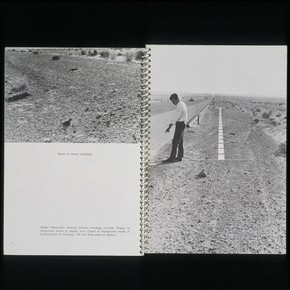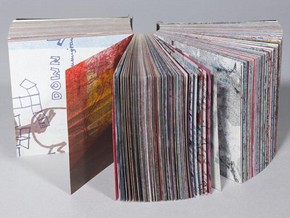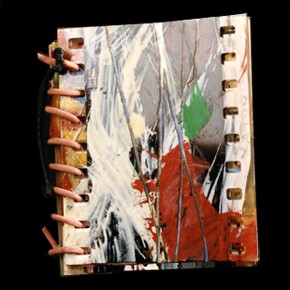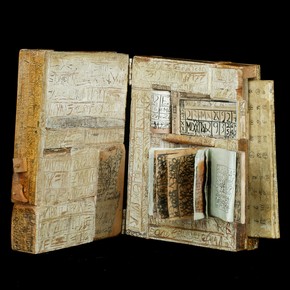Ainda em fase de preparação, mais um livro de artista dedicado e pensado a partir da obra do escritor português Camilo Castelo Branco. Todos os livros de artista que remetem para uma intervenção minha ou uma reconstrução sobre um livro já publicado têm acontecido pelo acaso dos encontros. Vêm parar às minhas mãos, ou em feiras de velharias, ou lojas de antiguidades, antiquários, ou mesmo em pesquisas temáticas na internet e depois disso a curiosidade desperta, as ideias acontecem e a necessidade de construir algo torna-se uma energia captadora de novas pesquisas e afazeres. Aliás, se me perguntam qual o meu método esse é quase sempre o seu início, o acaso quando se cruza com a vontade revela(nos). E foi assim que fui descobrindo o Camilo como autor de inúmeros livros, de uma quantidade (para além da qualidade) imensa, e cujo espanto tem sido o meu maior motivo de trabalho em volta e sobre alguns dos seus textos. Aqueles que me têm surpreendido mais são traduções e/ou livros "mistério" que supostamente ele os fez mas pouco se sabe ainda sobre eles.
Descobrir um livro que se chama "um livro" foi um desses momentos de feliz despertar da curiosidade.
Como diz o próprio prefácio da obra:
"Um livro... Um livro! O título não diz nada à força de dizer tudo. Que
pensamento dominaria o autor quando assim batizava a sua obra? Seria o
espírito da vaidade ou do orgulho que entendera haver escrito o livro por
excelência nos versos que dava ao mundo? Seria antes fantasia de poeta que
deixava no indefinido o que era talvez indefinível? É certo que o misterioso tem
a atração do espírito; é certo que a vontade se prende ao desconhecido; é certo
que a fantasia se compras de se demorar no enigma.
(...)
Transcrever aqui os trechos que mais nos impressionaram fora tarefa prolixa e
improveitosa. O livro é tão repassado de melancolias que num momento os 13
nossos rostos imberbes assumiram as tintas daquela tristeza suave que formam
o seu fundo e o seu tom característico. Estávamos identificados com o poeta. A
isso nos convidava a primeira estrofe do poema:
Soledade, triste amiga,
vim buscar nos teus afagos
suavidade à minha cruz;
dá-me aqueles sonhos vagos,
aquelas crenças ditosas,
em que a alma folga e espera
paz e amor, esp’rança e luz.
Era um coração que se nos apresentava triste foi-nos bem-vindo assim.
Começava a narração dos suaves amores do poeta; amores entrelaçados de
açucenas e saudades, de inocências e amarguras.
(...)
***
Camilo: Já vê; escrevi de si o menos que podia; menos, muito menos do que
devia.
Não o coloco abaixo nem acima de pessoa alguma; não o quis comparar. O lugar
que lhe pertence na hierarquia literária não é nem pode ser mercê de ninguém.
A liturgia pára onde começam as legitimas conquistas. O que o seu talento lhe
ganhou, é seu por direito próprio. Negar-lho é um crime; oferecer-lho uma
indelicadeza.
Sei que Um livro não é a sua obra predileta; acusa-lhe muitos defeitos, e alguns
terá; mas eu não vejo nele senão o muito que lhe quero. 18
Consinta pois que no princípio ou no fim da terceira edição fique nele o meu
nome subscrevendo este singelo documento da muita admiração e amizade que
lhe consagra.
Lisboa, 8 de Setembro de 1865
Tomás Ribeiro"
about inspiration...
are there new Ideas or just different people finding themselves in related universes of emotions, thoughts, expressions - and I found a curious definition about the word "inspiration": "divine guidance or influence exerted directly on the mind and soul of humankind", so, these are people whom I become to met and notice because I felt they had the same kind of similar "makeind" as me... or maybe I met them before I am... in a kind of parallel universe connected by what we call art... _________ in some how those are the kind of experiences that sometimes make me feel kind of espiritual beeing in this material world
 |
Palladian Xmas” (1980), with acrylic, fabric and collage on wood |
 |
| Robert Rauschenberg, Minutiae, 1954 (installation of backdrops, props, and costumes created for the Merce Cunningham Dance Company ) |
Victoria and Albert Museum The world’s greatest museum of art and design
Artists' Books
Artists' books are books made or conceived by artists. There are fine artists who make books and book artists who produce work exclusively in that medium, as well as illustrators, typographers, writers, poets, book binders, printers and many others who work collaboratively or alone to produce artists' books. Many artists' books are self-published, or are produced by small presses or by artists' groups or collectives, usually in limited editions.
Artists' books that maintain the traditional structure of a book are often known as book art or bookworks, while those that reference the shape of a book are known as book objects. Other types of work produced by artists in book format include concrete poetry, where meaning is derived from the spatial, pictorial and typographic characteristics of the work, as well as from the sense of the words.
Contemporary artists' books are noteworthy for their many different forms and perhaps because of this they have an equally large number of precursors and influences. Artists have been associated with the written word since illuminated manuscripts were developed in the medieval period. Many have been concerned with books as an artistic enterprise, notably William Blake at the end of the 18th century and William Morris at the Kelmscott Press from the 1890s. Avant-garde artists throughout the 20th century also produced many books as part of their artistic endeavours.
It is however the livre d'artiste, also known as the livre de peintre, that is generally considered to be a key precursor to the contemporary artists' book. Originating in France around the turn of the 20th century, the livre d'artisteis a form of illustrated book. They are distinguished by the fact that the pages have been printed directly from a source created by the artist themselves rather than from a source that has been created by a technician from the artist's design. An early exponent of the livre d'artiste was the dealer Ambroise Vollard who commissioned Pierre Bonnard to illustrate with lithographs a collection of poems by Paul Verlaine, Parallèlement, published in Paris in 1900 (NAL pressmark: Safe 1.A.1). The works produced were essentially deluxe, limited editions, produced on high quality paper using specialised printmakers. They were generally left unbound so that they could be dismantled for display and so that bespoke bindings could be commissioned if desired. Vollard produced numerous works in association with a number of artists, matching them up with texts to illustrate. Various other publishers followed suit, collaborating with artists of their own association. The National Art Library holds a number of livres d'artisteswhich are described in the exhibition catalogue: From Manet to Hockney: modern artists' illustrated books, edited by Carol Hogben and Rowan Watson, London: Victoria and Albert Museum, 1985 (NAL pressmark: CTR REF).

'Royal Road Test', artists' book by Edward Ruscha, Patrick Blackwell and Mason Williams, Los Angeles, California, USA, 1967. Pressmark SC.99.0036
In the 1950s and 1960s Swiss-German artist Dieter Roth (1930–98) and American artist Ed Ruscha (1937–) created conceptual works which are considered the foundation of the artists' book genre. In 1962 Ruscha published the first edition of Twenty-six gasoline stations (NAL pressmark: SA.91.0042) which comprised 26 deadpan photographs of gasoline stations along Route 66 from Los Angeles to Oklahoma City. The book was not intended as a means for the reproduction of pre-existing photographs, but rather as an artwork in its own right. As the piece retains the essential characteristics of a book, such as the idea of seriality and sequence provided by the turning of pages, it is considered central to the development of the genre. Ruscha produced a series of bookworks in a similar vein. Another characteristic of this series was that they were published in unlimited editions, had a wide distribution and were inexpensive to buy, in a deliberate attempt to bring art to a wider audience.
Roth's distinctive contribution to the genre was his examination, through his bookworks, of the formal qualities of books themselves. These formal qualities, such as flat pages bound into fixed sequences, were deconstructed and investigated, this investigation becoming the subject matter of the book itself. For example 2 Bilderbücher (1957) (NAL pressmark: X920000) consists of two picture books of geometric shapes with die-cut holes cut into each page to allow glimpses of patterns from the pages beneath. Subsequent works such as Daily Mirror (1961) involved the use of found materials manipulated to a particular purpose, a technique that was much used by later book artists.

'Little Tentative Recipe', artists' book by Dieter Roth, published by Watford School of Art, England, UK, about 1969. Pressmark 95.S.43
Artists' books became popular throughout the 1960s and early 1970s and the genre has continued to expand. During the 1980s and 1990s many more artists began to use the book as a medium for self-expression and they continue to do so. Techniques remain varied and range from the traditional to the experimental. Small presses and individuals have continued to promote the art of letterpress printing and the hand-crafted book. Some artists have chosen to use computer-generated images while others have used the photocopier to reproduce their work. Many artists have taken up the challenge to experiment with the content and physical structure of the traditional book form. Bookworks and book objects have continued to step outside conventional boundaries to encompass concepts associated with the fine arts. Works range from the minuscule to the gargantuan. Bookworks are not restricted to the use of paper and ink but can incorporate all kinds of materials and appended objects. While such works are usually unique or limited editions, some are produced in multiple copies.
Artists' books in the Victoria & Albert Museum

'Filmboekje', artists' book by Beppe Kessler, Amsterdam, Netherlands, about 1987. Pressmark: X890073
The National Art Library holds the largest collection of artists' books in the UK. The collection is international in scope and is particularly strong in examples from the British Isles and the United States. The Library also has significant holdings from other western European countries, as well as some examples from Russia, Australia, Latin America, Japan and a number of other countries. The collection includes both multiples and unique works. New acquisitions of works are made on a highly selective basis.
Supporting material
The Library has an extensive collection of contextual material, known as the Artists' Book Reference Collection, for research into artists' books. The Artists' Books Reference Collection can be browsed on the NAL Catalogue by choosing the NAL pressmark search from the drop-down list and searching under the pressmark AB. The second element of the pressmark indicates the year a particular work was published, e.g. AB.88.0010 indicates a work in the Artists' Books Reference Collection published in 1988. Information files, many of which contain ephemeral documentation about individual book artists and their books and presses, are also available for consultation.
The Library has an extensive collection of contextual material, known as the Artists' Book Reference Collection, for research into artists' books. The Artists' Books Reference Collection can be browsed on the NAL Catalogue by choosing the NAL pressmark search from the drop-down list and searching under the pressmark AB. The second element of the pressmark indicates the year a particular work was published, e.g. AB.88.0010 indicates a work in the Artists' Books Reference Collection published in 1988. Information files, many of which contain ephemeral documentation about individual book artists and their books and presses, are also available for consultation.
Catalogues
Artists' books are all listed on the NAL catalogue. Known items may be found by searching under the artist's name or the title of the book. Items can also be found by selecting a Genre or Publication Format Keyword search from the dropdown list and entering the appropriate search term e.g. artists books, book objects, pop-up books, etc.
Artists' books are all listed on the NAL catalogue. Known items may be found by searching under the artist's name or the title of the book. Items can also be found by selecting a Genre or Publication Format Keyword search from the dropdown list and entering the appropriate search term e.g. artists books, book objects, pop-up books, etc.
Access to Artists' Books
Access to the Library is by reader's ticket. For more information see, Registering to use the National Art Library. Due to the fragile nature of much of the material, readers are encouraged to be selective in choosing the items they wish to see. A maximum of six items may be seen in any one day without an appointment.
Access to the Library is by reader's ticket. For more information see, Registering to use the National Art Library. Due to the fragile nature of much of the material, readers are encouraged to be selective in choosing the items they wish to see. A maximum of six items may be seen in any one day without an appointment.
Group visits can also be arranged to look at artists' books in the Library's collections.
The V&A is committed to respecting the intellectual property rights of others. We have therefore made all reasonable efforts to ensure that the reproduction of content on these pages is done with the full consent of copyright owners and that all credits are correct. We apologise for any inadvertent omissions. If for some reason a credit has been omitted, or there are queries in this respect, please email webmaster@vam.ac.uk
Subscrever:
Mensagens (Atom)







